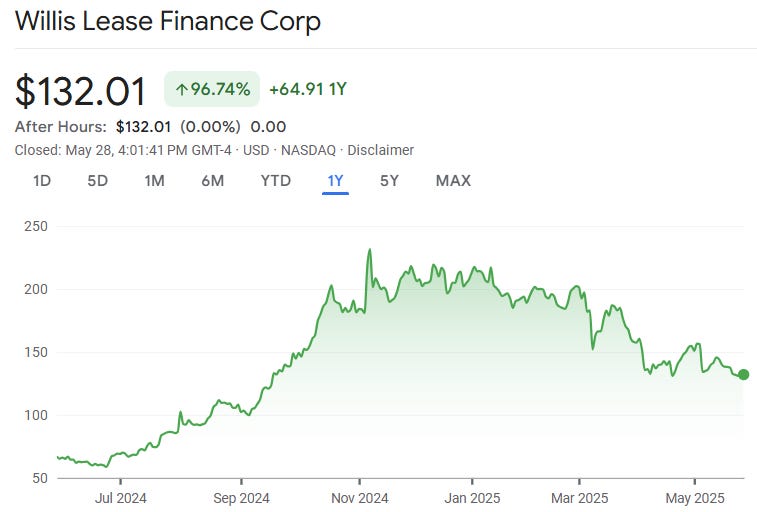Episode 4: WLFC
Uncovering WLFC: An Undervalued Giant in Engine Leasing
In a quiet corner of the U.S. stock market, one small-cap company has been quietly doubling its share price—without much Wall Street attention. Willis Lease Finance Corporation (WLFC) specializes in leasing spare jet engines, a niche most investors ignore. But in today’s post-pandemic aviation landscape, that niche is turning into a goldmine.
Since COVID, global air travel has roared back. In 2024, passenger traffic hit a record high—up 9% year-over-year. But while demand recovered quickly, supply didn’t. Boeing and Airbus remain stuck in production bottlenecks, and Airbus alone has over 8,500 planes on backlog—meaning most airlines face multi-year waits for new aircraft.
At the same time, engine maintenance has become a major choke point. Pratt & Whitney’s GTF engines, known for design flaws, require over 30,000 parts per overhaul—any one part missing can delay the process by up to a year. CFM56 engines are aging out of warranty and flooding the repair market, pushing capacity to the limit.
The result? Spare engines are suddenly in high demand. Once seen as a sleepy, low-yield asset, they’ve become critical to airline operations—and WLFC, with its specialized short-term leasing model, is uniquely positioned to benefit.
Why Jet Engine Leasing Is Suddenly a Hot Market
Jet engines are the most expensive, complex, and failure-prone components on a commercial aircraft. A single mainstream engine can cost over $10 million, and when it breaks down, repairs are slow and costly. Worse yet, a grounded engine can take an entire aircraft out of service—leading to canceled flights, lost revenue, and unhappy customers.
Most twin-engine planes come equipped with two primary engines, but airlines often keep one or two spares on hand to ensure scheduling flexibility and operational resilience. Some even position extra engines at key airports—like spare train cars at major stations—ready to swap in during peak traffic or emergency situations. Larger carriers may build engine reserve pools for contingency planning.
In short, the actual market demand for engines far exceeds new aircraft delivery volumes.
But here’s the catch: buying spare engines outright ties up huge amounts of capital. In today’s environment of rising interest rates, thin airline margins, and clogged supply chains, ownership is both costly and rigid. That’s why short-term engine leasing has emerged as the more flexible, capital-efficient solution.
And in a world where new aircraft deliveries are delayed, repairs take longer, and engines are aging faster than they can be replaced, leasing isn’t just a tactical move—it’s becoming a strategic necessity.
How Engine Leasing Differs from Aircraft Leasing
Engine leasing isn’t just a smaller version of aircraft leasing—it’s a different model entirely, with faster cycles, more flexibility, and higher asset turnover:
Shorter terms, faster returns
Aircraft leases run 7–12 years. Engine leases are just 16 months on average. That means pricing can adjust quickly with market conditions—ideal for capturing upside in tight supply cycles.More tactical, less strategic
Aircraft leasing fuels long-term fleet growth. Engine leasing is about operational backup—swapping out failed engines, covering seasonal peaks, or keeping one on standby at busy hubs. It’s a real-time problem-solver.Standardized and mobile
Engines are plug-and-play across fleets. Unlike whole aircraft, they can be shipped, reused, or reassigned globally within days. That makes them far more liquid and responsive as assets.
Meet WLFC: The Jet Engine Specialist Wall Street Overlooked
WLFC is the only publicly listed company in the world focused solely on aircraft engine leasing. That niche focus—and decades of quiet execution—gives it a unique edge in today’s supply-constrained aviation market.
Founded in 1985 and headquartered in Florida, near major U.S. aviation maintenance hubs, WLFC was built by Charles Willis, who started in aviation finance. In the early 1980s, he acquired a few retired engines from a small leasing firm—laying the groundwork for a global platform.
WLFC’s early model was simple: buy engines from OEMs or airlines and lease them out. Over time, the company built a global customer base and a sizable asset pool. It went public on NASDAQ in 1996.
As of 2024, WLFC manages over 500 engines, spanning key models like the CFM56, V2500, LEAP, and GTF. Its clients include major airlines, MROs, and parts suppliers around the world.
Unlike large aircraft lessors like AerCap or Air Lease, which focus on long-term fleet leasing, WLFC specializes in short-term engine leases. This gives it more pricing flexibility, faster turnover, and greater upside during market dislocations—like the one playing out right now.
Keep reading with a 7-day free trial
Subscribe to 价值派 to keep reading this post and get 7 days of free access to the full post archives.


